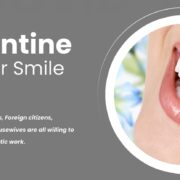Tongue thrusting is the behavior of pressing the tongue against the front teeth while swallowing or at rest. Tongue thrusting can result in several dental and speech issues. We’ll go into the specifics of it in this blog post, but more significantly, we’ll offer helpful advice on how to break the habit. Making use of simple methods and comprehending the underlying issues can have a big impact. Thus, if you’ve been wondering “how to stop tongue thrusting, for better oral health” you’ve found the appropriate resource. Together, we can tackle this issue and open the door to better dental hygiene. Let’s get started.
What is Tongue Thrusting?
Scientifically referred to as orofacial muscle imbalance, tongue thrusting is the involuntary pressing of the tongue against the front teeth during speaking, eating, or even just relaxing. This seemingly harmless behavior may result from a number of things, including:
Improper Swallowing Patterns: Individuals with it often exhibit improper swallowing, where the tongue pushes against the front teeth instead of the roof of the mouth.
Thumb-Sucking in Childhood: Prolonged thumb-sucking can contribute to it, as it may alter the normal development of oral muscles.
Structural Issues: Anatomical irregularities or deviations in the structure of the oral cavity can also trigger it.
Impact on Dental and Facial Development
Tongue thrusting has consequences that go beyond oral habits and have a significant influence on the development of the teeth and face, such as the fact that the constant pressure from it can result in misaligned teeth, affecting both the aesthetics and functionality of the bite. It is a common culprit behind the development of an open bite, where the front teeth don’t meet when the mouth is closed. Prolonged tongue thrusting can contribute to facial asymmetry, affecting the overall harmony of facial features.

Connection Between Tongue Thrusting and Speech Difficulties
Speaking problems are closely related to tongue thrusting, even if it has no effect on the anatomy of the mouth. As a result of the complex interaction, speech difficulties may result from improper tongue motions that are necessary for clear articulation. Variations in tongue placement can impact the articulation of particular sounds, leading to abnormalities in speech.
Prevalence of the Tongue Thrusting Habit across Age Groups
It is not limited to any particular age range; rather, it can occur at any point in life. Comprehending the incidence rate across various age cohorts is crucial for focused interventions. Important findings consist of:
Children: Tongue thrusting often emerges in childhood, linked to habits like thumb-sucking and the development of oral motor skills.
Adolescents: Hormonal changes and increased self-awareness may contribute to the persistence of tongue thrusting in adolescents.
Adults: Lingering habits from childhood, coupled with stress-induced behaviours, make tongue thrusting prevalent in adults.
Tongue Thrusting Habits – Signs and Symptoms to Look Out For
Knowing the warning signs and symptoms of tongue thrusting is essential to uncovering its subtle but powerful presence. noticing the tongue constantly sticking out in front of the teeth when speaking or swallowing. Clearly audible speech impairments or trouble pronouncing specific sounds are signs of possible tongue-pushing interference.
Prolonged tongue thrusting often results in a gap between the upper and lower front teeth when the mouth is closed. Tongue thrusting and its effects on nasal breathing may be related to habitual mouth breathing. Mouth thrusting can cause the muscles in the face to change, giving the illusion of an uneven face.
Importance of Early Detection in Preventing Complications
It’s like catching a possible storm before it intensifies into a hurricane when tongue thrusting is discovered early. Early intervention helps maintain a tooth’s natural alignment by reducing the likelihood of severe misalignment and orthodontic difficulties. Early detection of tongue thrusting allows for focused interventions to promote healthy speech development and prevent potential obstacles.

Treatment of tongue thrusting might lessen its psychological effects and avert future problems with confidence and self-worth brought on by dental imperfections. Prompt intervention lowers the chance of long-term cosmetic repercussions by maintaining face symmetry.
Link Between Tongue Thrusting and Oral Health
Impact on Teeth Alignment and Bite
The bite and tooth alignment can be greatly affected by it. The incessant press of the tongue on the teeth, particularly when swallowing, can result in malocclusion, or tooth misalignment. Dental problems such as overbites, underbites, and crossbites can be caused by malocclusion.
In addition to raising the possibility of dental issues, including cavities and gum disease, this misalignment may detract from the smile’s overall appearance. The need for early intervention and individualised treatment strategies is shown by Dr. Chirag Chamria’s proficiency in managing dental alignment problems resulting from it.
Contribution to Orofacial Myofunctional Disorders
Problems with orofacial myofunctional disorders refer to abnormalities in the way the mouth and face’s muscles and tissues work. Because tongue thrusting interferes with the orofacial muscles’ normal function, it is frequently linked to these illnesses.
The repeated thrusting motion can cause aberrant muscle patterns that impair face development, speaking, and chewing. The difficulties brought on by tongue pushing can be made worse by orofacial myofunctional problems, which can lead to a vicious cycle of dysfunction. In order to address the structural and functional components of the problem, Dr. Chirag Chamria’s specialist approach to orofacial myofunctional disorders includes both dentistry and myofunctional therapy.
Strategies to Stop Tongue Thrusting
Demonstrations of Effective Exercises
- Tongue Posture Correction: illustrated techniques to encourage proper tongue posture, guiding it away from the front teeth during swallowing or at rest.
- Swallowing Re-Training: Step-by-step demonstrations to retrain swallowing patterns, redirecting the tongue to its natural position on the roof of the mouth.
- Myofunctional Exercises: Engaging exercises that strengthen oral muscles promote optimal function and reduce the likelihood of tongue thrusting.
Step-by-Step Guide on Implementing Therapy at Home
- Identification of Triggering Situations: Recognizing scenarios that prompt tongue thrusting to enhance mindfulness.
- Consistent Practice: Establishing a routine for performing exercises consistently fosters muscle memory and habit change.
- Tracking Progress: Guidance on monitoring progress and making necessary adjustments to the therapy plan.

Dental Appliances for Correcting Tongue Thrusting
- Orthodontic Devices: Exploring appliances designed to address misalignments caused by tongue thrusting, supporting the natural alignment of teeth.
- Tongue Cribs and Spurs: describing specialised devices that discourage it by creating barriers or providing sensory feedback.
- Collaboration with Orthodontic Professionals: Highlighting the importance of consultation with orthodontic professionals for personalised appliance recommendations and fitting.
Dr. Chirag Chamria’s Approach
To fully grasp each patient’s particular situation, Dr. Chirag Chamria conducts a comprehensive assessment. This entails determining the extent of it, how it affects oral structures, and whether there are any related disorders. The assessment develops individualised treatment regimens. Dr. Chamria ensures a focused and efficient approach by taking into account variables like age, general health, and the unique problems that each individual presents
Dr. Chamria accurately diagnoses and assesses tongue thrusting problems with the use of cutting-edge diagnostic instruments and technologies. This could involve 3D scans, intraoral cameras, or digital photography to provide a thorough grasp of the oral architecture.
Conclusion
We have investigated prevention and therapy methods, investigated the subtleties of tongue thrusting, and examined the critical role that early diagnosis plays in this battle against it. For individualized advice, think about speaking with reputable dentist Dr. Chirag Chamria. Recall that you have the ability to create a vibrant, tongue-thrust-free grin with regular exercises, dental treatments, and behavioural adjustments. Unlock the doors to a healthier, more confident you by embracing the journey and seeking professional assistance. You should give your teeth and oral health the attention they require.





